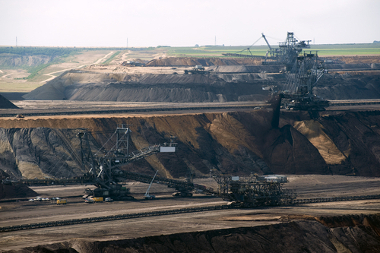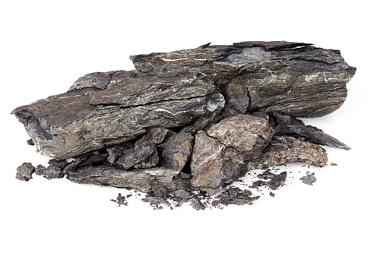Non-renewable energy sources are those that use exhaustible natural resources, that is, that will have an end, either in the near future, or in the medium or long term. In some cases, this type of energy usually presents environmental problems, in addition to disputes involving the extraction and sale of its raw materials.
The main examples of non-renewable energy sources are fossil fuels (oil, mineral coal, natural gas and oil shale) and nuclear fuels. Below, you can check a summary of each of these types mentioned.
Petroleum
O Petroleum it is, even today, the main raw material and one of the main sources of energy in the world. Therefore, its extraction and use were and still are targets of conflicts involving imperialist powers and producing and refining countries. It is, therefore, a natural resource of a strategic nature, as it is widely used by vehicles, constituting a an important element in the means of transport, in addition to being able to be used in the manufacture of by-products, notably the plastic.

oil extraction platform
It is known that oil is a hydrocarbon which is formed from the deposition of organic remains of animals and plants on the ocean floor, where the sedimentary basins. Thus, the burial of this material during the consolidation of the different layers of sediment along the years gives rise to an oxygen-deprived environment that becomes conducive to the constitution of Hydrocarbons.
Fuels from petroleum are deeply criticized from an environmental point of view, as their burning is responsible for emitting pollutants into the atmosphere. For this reason, several countries and entities have been looking for alternatives, such as biofuels. Furthermore, the use of other energy sources would also be an important way to depend less economically on this type of natural resource. Even so, we can say that we live in the “oil age”, in which those who dominate or control the use of this material have, around them, ample economic and political power.
Mineral coal
O mineral coal came to be widely used from the industrial revolutions resulting from capitalism, it is still today a widely used energy source around the world, second only to the Petroleum. In total, it corresponds to just under 26% of the resources used in energy production worldwide, a figure that drops to around 6% in Brazil.

Coal extraction area, one of the most used energy sources on the planet
THE coal formation it resembles, in part, that of oil, as both (and also natural gas) are fossil fuels, which were formed in sedimentary areas. During the Carboniferous period of the Paleozoic Era, there were areas with immense forests and swamps where there was a gradual accumulation of dead plants, constituting an organic material that was several times buried by several layers of sediments. Thus, over time, a natural condition of great pressure was formed on this material, which was transformed into mineral coal.
To extract coal from underground, tunnels and wells are built. In some cases, its availability occurs in areas of environmental or forest reserves, which can generate high environmental impacts. In addition, burning coal is considered to be even more polluting than burning oil. This material was widely used in iron trains as fuel and is also adopted in some types of thermoelectric power plants.
Do not stop now... There's more after the advertising ;)
Natural gas
O natural gas it is nothing more than a mixture of light hydrocarbons in gaseous form, such as methane, ethane, propane, butane and others. Its reserves are almost always available in areas where oil is extracted, going through the same constitution process. However, unlike oil and coal, natural gas is less polluting, although its combustion still presents some levels of pollution that damage the atmosphere.

Natural gas production plant
Natural gas is widely used in thermoelectric plants, being considered a more advantageous source for have less environmental impact, greater ease of transport, in addition to an almost zero need for storage. It is also used as an energy source in industries, homes (cooking gas) and also in some types of vehicles with adaptation for this type of fuel.
The transport of natural gas is carried out through gas pipelines, which are medium cost structures for installation, but easy to maintain, which represents a certain advantage compared to other sources of energy. In Brazil, there are important areas of extraction of these resources, especially the Santos Basin, and there are also gas pipelines that transport oil taken from Bolivia, an import product.
oil shale
O oil shale is a fossil natural resource also found in areas of sedimentary rocks, where a material of organic origin, under certain conditions of pressure and temperature, forms and aggregates between these rocks. Thus, by heating them to about 500°C, you get the so-called shale oil, which is literally an act of “taking oil out of stone”.

Rock from which shale oil is extracted
Brazil has one of the largest oil shale reserves on the planet, which can be seen as a strategic condition. On the other hand, its extraction is not as advantageous, as it is considered a less efficient energy source and also with lower productivity, in addition to being responsible for profound environmental impacts both in its collection and combustion.
Nuclear energy
THE nuclear energy is obtained from the process of nuclear fission of uranium atoms, which is considered an exhaustible source of energy. When the fission of the core of this material occurs, a large amount of energy is released, which is used for the production, mainly, of electricity.

External image of a nuclear plant
It is a strategic energy resource, especially for countries or regions that have a low hydroelectric potential, in addition to being less dependent on other energy sources. Nuclear energies have larger reserves, use smaller areas and do not emit gaseous pollutants into the atmosphere.
On the other hand, there are many criticisms directed at nuclear energy due to its disadvantages, namely: the not always efficient disposal of atomic waste (radioactive and very dangerous) of the nuclear power plants, the high production costs, the high environmental and social risks in cases of accidents and also the fact that this is the same technology used to manufacture nuclear weapons.
By Me. Rodolfo Alves Pena


